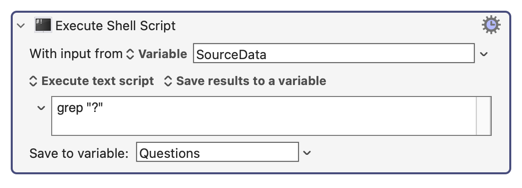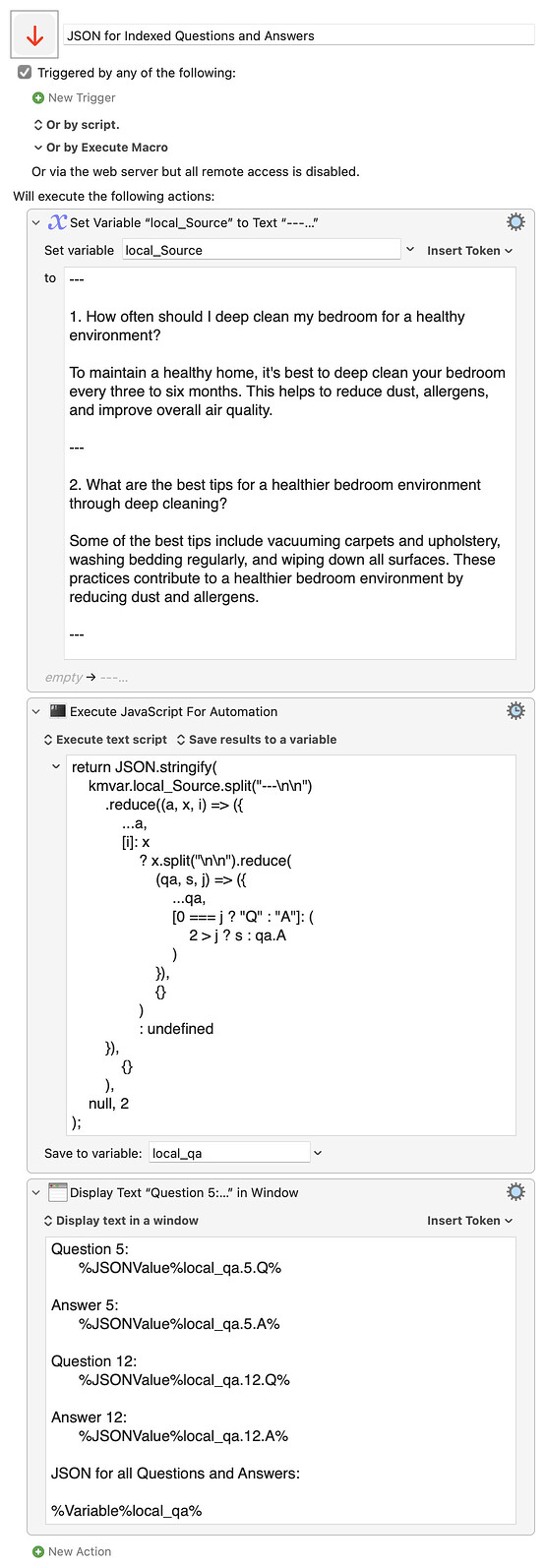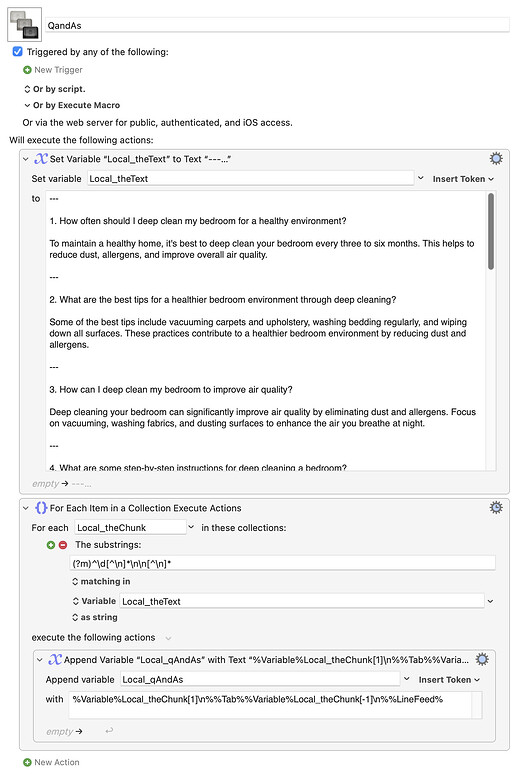I just have never gotten the 'for each' thing down.....
I have a master block of text that I will provide at the end of this text.
The block is 12 FAQs, 12 questions and 12 answers.
I want to extract the questions to variables cb01, cb03, cb05, cb07 etc up to cb23
I want to extract the answers to variables cb02, cb04, cb06, cb08 etc up to cb24
I have the regex that will capture the first question and answer.
Capture the question
Capture after a number followed by period, up to the question mark.
(?<=\d.\s)([^?]+)?
Capture the answer:
(?<=?\n\n)([^-]+)
I just can't get it to save to the variables and increment, which I have tried.....
I really appreciate any feedback.
---
1. How often should I deep clean my bedroom for a healthy environment?
To maintain a healthy home, it's best to deep clean your bedroom every three to six months. This helps to reduce dust, allergens, and improve overall air quality.
---
2. What are the best tips for a healthier bedroom environment through deep cleaning?
Some of the best tips include vacuuming carpets and upholstery, washing bedding regularly, and wiping down all surfaces. These practices contribute to a healthier bedroom environment by reducing dust and allergens.
---
3. How can I deep clean my bedroom to improve air quality?
Deep cleaning your bedroom can significantly improve air quality by eliminating dust and allergens. Focus on vacuuming, washing fabrics, and dusting surfaces to enhance the air you breathe at night.
---
4. What are some step-by-step instructions for deep cleaning a bedroom?
To deep clean a bedroom step by step, start by decluttering, washing your bedding, dusting surfaces, and cleaning floors. Don’t forget to vacuum under furniture and sanitize high-touch areas like light switches and door handles.
---
5. Why is it important to deep clean bedroom furniture for a healthier space?
Bedroom furniture collects dust, allergens, and germs over time. Deep cleaning furniture not only prolongs its life but also helps create a cleaner, healthier bedroom environment.
---
6. How can deep cleaning my bedroom help me sleep better?
A cleaner, dust-free bedroom can significantly improve your sleep quality. Deep cleaning your bedroom for better sleep removes allergens and creates a fresh, relaxing space.
---
7. What are the benefits of deep cleaning my bedroom to reduce allergens?
Deep cleaning your bedroom reduces allergens like dust mites and pet dander, leading to fewer allergy symptoms. This is especially important if anyone in your household suffers from allergies or asthma.
---
8. How do I sanitize and disinfect my bedroom properly?
Sanitizing and disinfecting your bedroom involves wiping down surfaces with a disinfectant, washing bedding in hot water, and vacuuming carpets to eliminate germs and allergens.
---
9. How can Muffetta's Housekeeping help with deep cleaning my bedroom for a healthier environment?
Muffetta's Housekeeping offers expert cleaning services to deep clean your bedroom, ensuring a healthier home environment. We use non-toxic products to remove allergens and dust effectively.
---
10. Why is deep cleaning crucial for maintaining good indoor air quality in my bedroom?
Deep cleaning is essential for good indoor air quality because it eliminates dust, dirt, and allergens that accumulate over time. Regular deep cleaning can make a noticeable difference in the air you breathe.
---
11. How can I remove dust and allergens from my bedroom effectively?
To effectively remove dust and allergens, regularly dust all surfaces, vacuum floors and carpets, and wash bedding in hot water. Muffetta's Housekeeping can help with professional bedroom cleaning to ensure thorough results.
---
12. What are some tips for keeping my bedroom dust-free after deep cleaning?
To keep your bedroom dust-free after a deep clean, dust surfaces regularly, change your bedding weekly, and use air purifiers to maintain cleaner air in the room.
---







